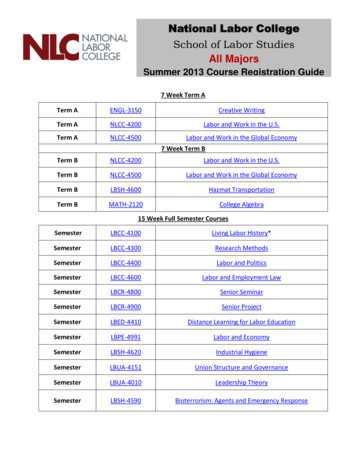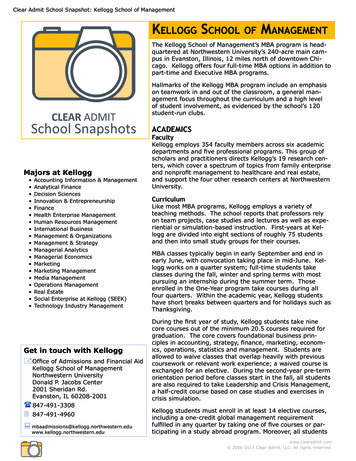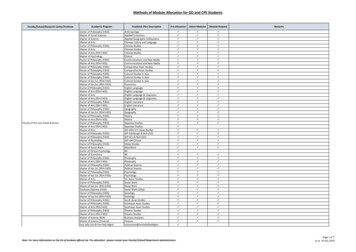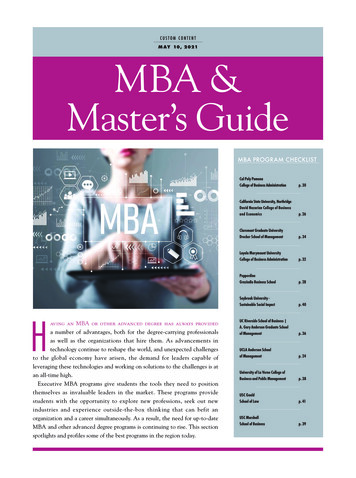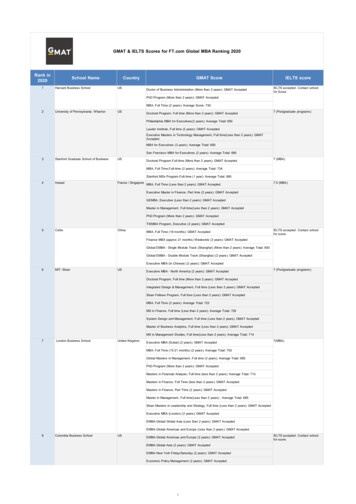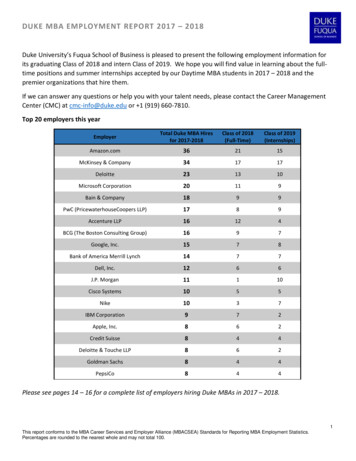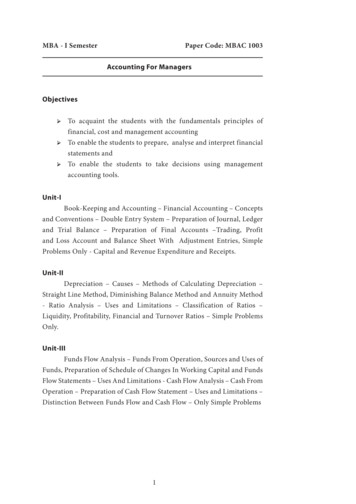
Transcription
MBA - I SemesterPaper Code: MBAC 1003Accounting For ManagersObjectivesՖՖ To acquaint the students with the fundamentals principles offinancial, cost and management accountingՖՖ To enable the students to prepare, analyse and interpret financialstatements andՖՖ To enable the students to take decisions using managementaccounting tools.Unit-IBook-Keeping and Accounting – Financial Accounting – Conceptsand Conventions – Double Entry System – Preparation of Journal, Ledgerand Trial Balance – Preparation of Final Accounts –Trading, Profitand Loss Account and Balance Sheet With Adjustment Entries, SimpleProblems Only - Capital and Revenue Expenditure and Receipts.Unit-IIDepreciation – Causes – Methods of Calculating Depreciation –Straight Line Method, Diminishing Balance Method and Annuity Method- Ratio Analysis – Uses and Limitations – Classification of Ratios –Liquidity, Profitability, Financial and Turnover Ratios – Simple ProblemsOnly.Unit-IIIFunds Flow Analysis – Funds From Operation, Sources and Uses ofFunds, Preparation of Schedule of Changes In Working Capital and FundsFlow Statements – Uses And Limitations - Cash Flow Analysis – Cash FromOperation – Preparation of Cash Flow Statement – Uses and Limitations –Distinction Between Funds Flow and Cash Flow – Only Simple Problems1
Unit-IVMarginal Costing - Marginal Cost and Marginal Costing Importance - Break-Even Analysis - Cost Volume Profit Relationship –Application of Marginal Costing Techniques, Fixing Selling Price, Makeor Buy, Accepting a Foreign Order, Deciding Sales Mix.Unit-VCost Accounting - Elements of Cost - Types of Costs - Preparationof Cost Sheet – Standard Costing – Variance Analysis – Material Variances– Labour Variances – Simple Problems Related to Material And LabourVariances Only.[note: distribution of questions between problems and theory of thispaper must be 60:40 i.e., problem questions: 60 % & theory questions:40 %]REFERENCESJelsy Josheph Kuppapally, ACCOUNTING FOR MANAGERS, PHI, delhi,2010.Paresh Shah, BASIC ACCOUNTING FOR MANAGERS, Oxford, Delhi,2007.Ambrish Gupta, FINANCIAL ACCOUNTING FOR MANAGEMENT,Pearson, Delhi, 2004.Narayanaswamy R, FINANCIAL ACCOUNTING , PHI, Delhi, 2011.2
UNIT – I: Basics of AccountingLesson – 1.1 Accounting – An Introduction1.1.1 IntroductionAccounting is aptly called the language of business. This designationis applied to accounting because it is the method of communicatingbusiness information. The basic function of any language is to serve asa means of communication. Accounting duly serves this function. Thetask of learning accounting is essentially the same as the task of learninga new language. But the acceleration of change in business organizationhas contributed to increase the complexities in this language. Like otherlanguages, it is undergoing continuous change in an attempt to discoverbetter means of communications. To enable the accounting language toconvey the same meaning to all stakeholders, it should be made standard.To make it a standard language certain accounting principles, conceptsand standards have been developed over a period of time. This lessondwells upon the different dimensions of accounting, accounting concepts,accounting principles and the accounting standards.1.1.2 Learning ObjectivesAfter reading this lesson, the reader should be able to:ՖՖՖՖՖՖՖՖՖՖՖՖՖՖKnow the Evolution of AccountingUnderstand the Definition of AccountingComprehend the Scope and Function of AccountingAscertain the Users of Accounting InformationKnow the Specialized Accounting FieldsUnderstand the Accounting Concepts and ConventionsRealize the Need for Accounting Standards1.1.3 Contents1.2.Evolution of accountingBook keeping and accounting3
3.4.5.6.7.8.9.10.11.12.13.Definition of accountingScope and functions of accountingGroups interested in accounting informationThe profession of accountingSpecialized accounting fieldsNature and meaning of accounting principlesAccounting conceptsAccounting conventionsSummaryKey wordsSelf assessment questions1.1.3.1 Evolution Of AccountingAccounting is as old as money itself. It has evolved, as have medicine,law and most other fields of human activity in response to the social andeconomic needs of society. People in all civilizations have maintainedvarious types of records of business activities. The oldest known areclay tablet records of the payment of wages in babylonia around 600 b.c.accounting was practiced in india twenty-four centuries ago as is clearfrom kautilya’s book ‘arthshastra’ which clearly indicates the existence andneed of proper accounting and audit.For the most part, early accounting dealt only with limited aspectsof the financial operations of private or governmental enterprises.Complete accounting system for an enterprise which came to be calledas “double entry system” was developed in italy in the 15th century. Thefirst known description of the system was published there in 1494 by afranciscan monk by the name luca pacioli.The expanded business operations initiated by the industrialrevolution required increasingly large amounts of money which in turnresulted in the development of the corporation form of organizations.As corporations became larger, an increasing number of individuals andinstitutions looked to accountants to provide economic information aboutthese enterprises. For e.g. Prospective investors and creditors soughtinformation about a corporation’s financial status. Government agenciesrequired financial information for purposes of taxation and regulation.Thus accounting began to expand its function of meeting the needs of4
relatively few owners to a public role of meeting the needs of a variety ofinterested parties.1.1.3.2 Book Keeping And AccountingBook-keeping is that branch of knowledge which tells us howto keep a record of business transactions. It is considered as an art ofrecording systematically the various types of transactions that occur in abusiness concern in the books of accounts. According to spicer and pegler,“book-keeping is the art of recording all money transactions, so thatthe financial position of an undertaking and its relationship to both itsproprietors and to outside persons can be readily ascertained”. Accountingis a term which refers to a systematic study of the principles and methodsof keeping accounts. Accountancy and book-keeping are related terms; theformer relates to the theoretical study and the latter refers to the practicalwork.1.1.3.3 Definition Of AccountingBefore attempting to define accounting, it may be made clear thatthere is no unanimity among accountants as to its precise definition.Anyhow let us examine three popular definitions on the subject:Accounting has been defined by the american accounting associationcommittee as:“the process of identifying, measuring and communicating economicinformation to permit informed judgments and decisions by users of theinformation”. This may be considered as a good definition because of itsfocus on accounting as an aid to decision making.The american institute of certified and public accountants committee onterminology defined accounting as:“accounting is the art of recording, classifying and summarizing, in asignificant manner and in terms of money, transactions and eventswhich are, in part at least, of a financial character and interpreting theresults thereof ”. of all definitions available, this is the most acceptable onebecause it encompasses all the functions which the modern accountingsystem performs.5
Another popular definition on accounting was given by americanaccounting principles board in 1970, which defined it as:“accounting is a service society. Its function is to provide quantitativeinformation, primarily financial in nature, about economic entities thatis useful in making economic decision, in making reasoned choices amongalternative courses of action”.This is a very relevant definition in a present context of businessunits facing the situation of selecting the best among the various alternativesavailable. The special feature of this definition is that it has designatedaccounting as a service activity.1.1.3.4 Scope And Functions Of AccountingIndividuals engaged in such areas of business as finance,production, marketing, personnel and general management need not beexpert accountants but their effectiveness is no doubt increased if theyhave a good understanding of accounting principles. Everyone engagedin business activity, from the bottom level employee to the chief executiveand owner, comes into contact withaccounting. The higher the level ofauthority and responsibility, the greater is the need for an understandingof accounting concepts and terminology.A study conducted in united states revealed that the most commonbackground of chief executive officers in united states corporations wasfinance and accounting. Interviews with several corporate executives drewthe following comments:“ my training in accounting and auditing practice has been extremelyvaluable to me throughout”. “a knowledge of accounting carried with itunderstanding of the establishment and maintenance of sound financialcontrols- is an area which is absolutely essential to a chief executiveofficer”.Though accounting is generally associated with business, it isnot only business people who make use of accounting but also manyindividuals in non-business areas that make use of accounting data andneed to understand accounting principles and terminology. For e.g. Anengineer responsible for selecting the most desirable solution to a technical6
manufacturing problem may consider cost accounting data to be thedecisive factor. Lawyers want accounting data in tax cases and damagesfrom breach of contract. Governmental agencies rely on an accounting datain evaluating the efficiency of government operations and for approvingthe feasibility of proposed taxation and spending programs. Accountingthus plays an important role in modern society and broadly speaking allcitizens are affected by accounting in some way or the other.Accounting which is so important to all, discharges the following vitalfunctions:Keeping Systematic Records:This is the fundamental function of accounting. The transactionsof the business are properly recorded, classified and summarized into finalfinancial statements – income statement and the balance sheet.Protecting The Business Properties:The second function of accounting is to protect the propertiesof the business by maintaining proper record of various assets and thusenabling the management to exercise proper control over them.Communicating The Results:As accounting has been designated as the language of business, itsthird function is to communicate financial information in respect of netprofits, assets, liabilities, etc., to the interested parties.Meeting Legal Requirements:The fourth and last function of accounting is to devise such asystem as will meet the legal requirements. The provisions of various lawssuch as the companies act, income tax act, etc., require the submission ofvarious statements like income tax returns, annual accounts and so on.Accounting system aims at fulfilling this requirement of law.7
It may be noted that the functions stated above are those of financialaccounting alone. The other branches of accounting, about which weare going to see later in this lesson, have their special functions with thecommon objective of assisting the management in its task of planning,control and coordination of business activities. Of all the branches ofaccounting, management accounting is the most important from themanagement point of view.As accounting is the language of business, the primary aim ofaccounting, like any other language, is to serve as a means of communication.Most of the world’s work is done through organizations – groups of peoplewho work together to accomplish one or more objectives. In doing its work,an organization uses resources – men, material, money and machine andvarious services. To work effectively, the people in an organization needinformation about these sources and the results achieved through usingthem. People outside the organization need similar information to makejudgments about the organization. Accounting is the system that providessuch information.Any system has three features, viz., input, processes and output.Accounting as a social science can be viewed as an information system,since it has all the three features i.e., inputs (raw data), processes (menand equipment) and outputs (reports and information). Accountinginformation is composed principally of financial data about businesstransactions. The mere records of transactions are of little use in making“informed judgments and decisions”. The recorded data must be sortedand summarized before significant analysis can be prepared. Some ofthe reports to the enterprise manager and to others who need economicinformation may be made frequently; other reports are issued only atlonger intervals. The usefulness of reports is often enhanced by varioustypes of percentage and trend analyses. The “basic raw materials” ofaccounting are composed of business transactions data. Its “primary endproducts” are composed of various summaries, analyses and reports.The information needs of a business enterprise can be outlined andillustrated with the help of the following chart:8
Chart Showing Types Of ngInformationFinancialInformationNon- rmationThe chart clearly presents the different types of informationthat might be useful to all sorts of individuals interested in the businessenterprise. As seen from the chart, accounting supplies the quantitativeinformation. The special feature of accounting as a kind of a quantitativeinformation and as distinguished from other types of quantitativeinformation is that it usually is expressed in monetary terms.In this connection it is worthwhile to recall the definitions ofaccounting as given by the american institute of certified and publicaccountants and by the american accounting principles board.The types of accounting information may be classified into fourcategories: (1) operating information, (2) financial accounting information(3) management accounting information and (4) cost accountinginformation.9
Operating Information:By operating information, we mean the information which isrequired to conduct the day-to-day activities. Examples of operatinginformation are: amount of wages paid and payable to employees,information about the stock of finished goods available for sale and eachone’s cost and selling price, information about amounts owed to and owingby the business enterprise, information about stock of raw materials, spareparts and accessories and so on. By far, the largest quantity of accountinginformation provides the raw data (input) for financial accounting,management accounting and cost accounting.Financial Accounting:Financial accounting information is intended both for owners andmanagers and also for the use of individuals and agencies external to thebusiness. This accounting is concerned with the recording of transactionsfor a business enterprise and the periodic preparation of various reportsfrom such records. The records may be for general purpose or for a specialpurpose. A detailed account of the function of financial accounting hasbeen given earlier in this lesson.Management Accounting:Management accounting employs both historical and estimateddata in assisting management in daily operations and in planning forfuture operations. It deals with specific problems that confront enterprisemanagers at various organizational levels. The management accountantis frequently concerned with identifying alternative courses of actionand then helping to select the best one. For e.g. The accountant may helpthe finance manager in preparing plans for future financing or may helpthe sales manager in determining the selling price to be fixed on a newproduct by providing suitable data. Generally management accountinginformation is used in three important management functions: (1) control(2) co-ordination and (3) planning. Marginal costing is an importanttechnique of management accounting which provides multi dimensionalinformation that facilitates decision making.10
Cost Accounting:The industrial revolution in england posed a challenge tothe development of accounting as a tool of industrial management.This necessitated the development of costing techniques as guides tomanagement action. Cost accounting emphasizes the determination andthe control of costs. It is concerned primarily with the cost of manufacturingprocesses. In addition, one of the principal functions of cost accountingis to assemble and interpret cost data, both actual and prospective, for theuse of management in controlling current operations and in planning forthe future.All of the activities described above are related to accounting andin all of them the focus is on providing accounting information to enabledecisions to be made. More about cost accounting can be gained in unit v.1.1.3.5 Groups Interested In Accounting InformationThere are several groups of people who are interested in theaccounting information relating to the business enterprise. Following aresome of them:Shareholders:Shareholders as owners are interested in knowing the profitabilityof the business transactions and the distribution of capital in the form ofassets and liabilities. In fact, accounting developed several centuries agoto supply information to those who had invested their funds in businessenterprise.Management:With the advent of joint stock company form of organization thegap between ownership and management widened. In most cases theshareholders act merely as renders of capital and the management of thecompany passes into the hands of professional managers. The accountingdisclosures greatly help them in knowing about what has happened andwhat should be done to improve the profitability and financial position ofthe enterprise.11
Potential Investors:An individual who is planning to make an investment in a businesswould like to know about its profitability and financial position. Ananalysis of the financial statements would help him in this respect.Creditors:As creditors have extended credit to the company, they are muchworried about the repaying capacity of the company. For this purpose theyrequire its financial statements, an analysis of which will tell about thesolvency position of the company.Government:Any popular government has to keep a watch on big businessesregarding the manner in which they build business empires without regardto the interests of the community. Restricting monopolies is somethingthat is common even in capitalist countries. For this, it is necessary thatproper accounts are made available to the government. Also, accountingdata are required for collection of sale-tax, income-tax, excise duty etc.Employees:Like creditors, employees are interested in the financial statementsin view of various profit sharing and bonus schemes. Their interest mayfurther increase when they hold shares of the companies in which they areemployed.Researchers:Researchers are interested in interpreting the financial statementsof the concern for a given objective.Citizens:Any citizen may be interested in the accounting records of businessenterprises including public utilities and government companies as a voterand tax payer.12
1.1.3.6 The Profession Of AccountingAccountancy can very well be viewed as a profession withstature comparable to that of law or medicine or engineering. The rapiddevelopment of accounting theory and techniques especially after thelate thirties of 20th century has been accompanied by an expansion ofthe career opportunities in accounting and an increasing number ofprofessionally trained accountants. Among the factors contributing to thisgrowth has been the increase in number, size and complexity of businessenterprises, the imposition of new and increasingly complex taxes andother governmental restrictions on business operations.Coming to the nature of accounting function, it is no doubt aservice function. The chief of accounting department holds a staff positionwhich is quite in contra - distinction to the roles played by production ormarketing executives who hold line authority. The role of the accountantis advisory in character. Although accounting is a staff function performedby professionals within an organization, the ultimate responsibilityfor the generation of accounting information, whether financial ormanagerial, rests with management. That is why one of the top officers ofmany businesses is the financial controller. The controller is the personresponsible for satisfying other managers’ demands for managementaccounting information and for complying with the regulatory demandsof financial reporting. With these ends in view, the controller employsaccounting professionals in both management and financial accounting.These accounting professionals employed in a particular business firmare said to be engaged in private accounting. Besides these, there are alsoaccountants who render accounting services on a fee basis through staffaccountants employed by them. These accountants are said to be engagedin public accounting.1.1.3.7 Specialised Accounting FieldsAs in many other areas of human activity, a number of specializedfields in accounting also have evolved besides financial accounting.Management accounting and cost accounting are the result of rapidtechnological advances and accelerated economic growth. The mostimportant among them are explained below:13
Tax Accounting:Tax accounting covers the preparation of tax returns and theconsideration of the tax implications of proposed business transactionsor alternative courses of action. Accountants specializing in this branch ofaccounting are familiar with the tax laws affecting their employer or clientsand are up to date on administrative regulations and court decisions ontax cases.International Accounting:This accounting is concerned with the special problems associatedwith the international trade of multinational business organizations.Accountants specializing in this area must be familiar with the influencesthat custom, law and taxation of various countries bring to bear oninternational operations and accounting principles.Social Responsibility Accounting:This branch is the newest field of accounting and is the mostdifficult to describe concisely. It owes its birth to increasing socialawareness which has been particularly noticeable over the last threedecades or so. Social responsibility accounting is so called because it notonly measures the economic effects of business decisions but also theirsocial effects, which have previously been considered to be immeasurable.Social responsibilities of business can no longer remain as a passive chapterin the text books of commerce but are increasingly coming under greaterscrutiny. Social workers and people’s welfare organizations are drawing theattention of all concerned towards the social effects of business decisions.The management is being held responsible not only for the efficientconduct of business as reflected by increased profitability but also for whatit contributes to social well-being and progress.Inflation Accounting:Inflation has now become a world-wide phenomenon. Theconsequences of inflation are dire in case of developing and underdevelopedcountries. At this juncture when financial statements or reports are basedon historical costs, they would fail to reflect the effect of changes in14
purchasing power or the financial position and profitability of the firm.Thus, the utility of the accounting records, not taking care of price levelchanges is seriously lost. This imposes a demand on the accountants foradjusting financial accounting for inflation to know the real financialposition and profitability of a concern. Thus emerged a future branchof accounting called inflation accounting or accounting for price levelchanges. It is a system of accounting which regularly records all items infinancial statements at their current values.Human Resources Accounting:Human resources accounting is yet another new field of accountingwhich seeks to report and emphasize the importance of human resourcesin a company’s earning process and total assets. It is based on the generalagreement that the only real long lasting asset which an organizationpossesses is the quality and caliber of the people working in it. This systemof accounting is concerned with, “the process of identifying and measuringdata about human resources and communicating this information tointerested parties”.1.1.3.8 Nature And Meaning Of Accounting PrinciplesWhat is an accounting principle or concept or convention orstandard? Do they mean the same thing? Or does each one has its ownmeaning? These are all questions for which there is no definite answerbecause there is ample confusion and controversy as to the meaningand nature of accounting principles. We do not want to enter into thiscontroversial discussion because the reader may fall a prey to thecontroversies and confusions and lose the spirit of the subject.The rules and conventions of accounting are commonly referredto as principles. The american institute of certified public accountants hasdefined the accounting principle as, “a general law or rule adopted orprofessed as a guide to action; a settled ground or basis of conduct orpractice”. It may be noted that the definition describes the accountingprinciple as a general law or rule that is to be used as a guide to action.The canadian institute of chartered accountants has defined accountingprinciples as, “the body of doctrines commonly associated with the theoryand procedure of accounting, serving as explanation of current practices15
and as a guide for the selection of conventions or procedures wherealternatives exist”. This definition also makes it clear that accountingprinciples serve as a guide to action.The peculiar nature of accounting principles is that they aremanmade. Unlike the principles of physics, chemistry etc. They were notdeducted from basic axiom. Instead they have evolved. This has beenclearly brought out by the canadian institute of chartered accountants in thesecond part of their definition on accounting principles: “rules governingthe foundation of accounting actions and the principles derived from themhave arisen from common experiences, historical precedent, statementsby individuals and professional bodies and regulation of governmentalagencies”. Since the accounting principles are man made they cannot bestatic and are bound to change in response to the changing needs of thesociety. It may be stated that accounting principles are changing but thechange in them is permanent.Accounting principles are judged on their general acceptability tothe makers and users of financial statements and reports. They presenta generally accepted and uniform view of the accounting profession inrelation to good accounting practice and procedures. Hence the namegenerally accepted accounting principles.Accounting principles, rules of conduct and action are describedby various terms such as concepts, conventions, doctrines, tenets,assumptions, axioms, postulates, etc. But for our purpose we shall use allthese terms synonymously except for a little difference between the twoterms – concepts and conventions. The term “concept” is used to connoteaccounting postulates i.e. Necessary assumptions or conditions uponwhich accounting is based. The term convention is used to signify customsor traditions as a guide to the preparation of accounting statements.1.1.3.9 Accounting ConceptsThe important accounting concepts are discussed hereunder:Business Entity Concept:It is generally accepted that the moment a business enterprise is16
started it attains a separate entity as distinct from the persons who own it.In recording the transactions of a business, the important question is:How do these transactions affect the business enterprise? Thequestion as to how these transactions affect the proprietors is quiteirrelevant. This concept is extremely useful in keeping business affairsstrictly free from the effect of private affairs of the proprietors. In theabsence of this concept the private affairs and business affairs are mingledtogether in such a way that the true profit or loss of the business enterprisecannot be ascertained nor its financial position. To quote an example, if aproprietor has taken rs.5000/- from the business for paying house tax forhis residence, the amount should be deducted from the capital contributedby him. Instead if it is added to the other business expenses then the profitwill be reduced by rs.5000/- and also his capital more by the same amount.This affects the results of the business and also its financial position. Notonly this, since the profit is lowered, the consequential tax payment alsowill be less which is against the provisions of the income-tax act.Going Concern Concept:This concept assumes that the business enterprise will continueto operate for a fairly long period in the future. The significance of thisconcept is that the accountant while valuing the assets of the enterprise doesnot take into account their current resale values as there is no immediateexpectation of selling it. Moreover, depreciation on fixed assets is chargedon the basis of their expected life rather than on their market values. Whenthere is conclusive evidence that the business enterprise has a limited life,the accounting procedures should be appropriate to the expected terminaldate of the enterprise. In such cases, the financial statements could clearlydisclose the limited life of the enterprise and should be prepared from the‘quitting concern’ point of view r
MBA - I Semester Paper Code: MBAC 1003 Accounting For Managers Objectives Ֆ To acquaint the students with the fundamentals principles of . business concern in the books of accounts. A
